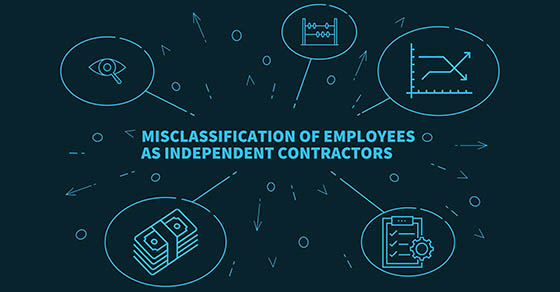Weekly Tax Brief
Traveling for business this summer? Here’s what you can deduct
- Details
- Published: 06 June 2023 06 June 2023

If you and your employees are traveling for business this summer, there are a number of considerations to keep in mind. Under tax law, in order to claim deductions, you must meet certain requirements for out-of-town business travel within the United States. The rules apply if the business conducted reasonably requires an overnight stay.
Note: Under the Tax Cuts and Jobs Act, employees can’t deduct their unreimbursed travel expenses on their own tax returns through 2025. That’s because unreimbursed employee business expenses are “miscellaneous itemized deductions” that aren’t deductible through 2025.
However, self-employed individuals can continue to deduct business expenses, including away-from-home travel expenses.
Rules that come into play
The actual costs of travel (for example, plane fare and cabs to the airport) are deductible for out-of-town business trips. You’re also allowed to deduct the cost of meals and lodging. Your meals are deductible even if they’re not connected to a business conversation or other business function. Although there was a temporary 100% deduction in 2021 and 2022 for business food and beverages provided by a restaurant, it was not extended to 2023. Therefore, there’s once again a 50% limit on deducting eligible business meals this year.
Keep in mind that no deduction is allowed for meal or lodging expenses that are “lavish or extravagant,” a term that’s been interpreted to mean “unreasonable.”
Personal entertainment costs on the trip aren’t deductible, but business-related costs such as those for dry cleaning, phone calls and computer rentals can be written off.
Mixing business with pleasure
Some allocations may be required if the trip is a combined business/pleasure trip, for example, if you fly to a location for four days of business meetings and stay on for an additional three days of vacation. Only the costs of meals, lodging, etc., incurred for the business days are deductible — not those incurred for the personal vacation days.
On the other hand, with respect to the cost of the travel itself (plane fare, etc.), if the trip is primarily business, the travel cost can be deducted in its entirety and no allocation is required. Conversely, if the trip is primarily personal, none of the travel costs are deductible. An important factor in determining if the trip is primarily business or personal is the amount of time spent on each (although this isn’t the sole factor).
If the trip doesn’t involve the actual conduct of business but is for the purpose of attending a convention, seminar, etc., the IRS may check the nature of the meetings carefully to make sure it isn’t a vacation in disguise. Retain all material helpful in establishing the business or professional nature of this travel.
Other expenses
The rules for deducting the costs of a spouse who accompanies you on a business trip are very restrictive. No deduction is allowed unless the spouse is an employee of you or your company, and the spouse’s travel is also for a business purpose.
Finally, note that personal expenses you incur at home as a result of taking the trip aren’t deductible. For example, let’s say you have to board a pet while you’re away. The cost isn’t deductible. Contact us if you have questions about your small business deductions.
© 2023
Being a gig worker comes with tax consequences
- Details
- Published: 01 June 2023 01 June 2023

In recent years, many workers have become engaged in the “gig” economy. You may think of gig workers as those who deliver take-out restaurant meals, walk dogs and drive for ride-hailing services. But so-called gig work seems to be expanding. Today, some nurses have become gig workers and writers in Hollywood who recently went on strike have expressed concerns that screenwriting is becoming part of the gig economy.
There are tax consequences when performing jobs that don’t involve taxes being deducted from a regular paycheck. The bottom line: If you receive income from freelancing or from one of the online platforms offering goods and services, it’s generally taxable. That’s true even if the income comes from a side job and even if you don’t receive an income statement reporting the amount of money you made.
Gig worker basics
The IRS considers gig workers those who are independent contractors and conduct their jobs through online platforms. Examples include Uber, Lyft, Airbnb and DoorDash.
Unlike traditional employees, independent contractors don’t receive benefits associated with employment or employer-sponsored health insurance. They also aren’t covered by the minimum wage or other federal law protections and they aren’t part of states’ unemployment insurance systems. In addition, they’re on their own when it comes to retirement savings and taxes.
Make quarterly payments during the year
If you’re part of the gig or sharing economy, here are some tax considerations.
- You may need to make quarterly estimated tax payments because your income isn’t subject to withholding. These payments are generally due on April 15, June 15, September 15 and January 15 of the following year. (If a due date falls on a Saturday, Sunday or holiday, the due date becomes the next business day.)
- You should receive a Form 1099-NEC, Nonemployee Compensation, a Form 1099-K or other income statement from the online platform.
- Some or all of your business expenses may be deductible on your tax return, subject to the normal tax limitations and rules. For example, if you provide rides with your own car, you may be able to deduct depreciation for wear and tear and deterioration of the vehicle. Be aware that if you rent a room in your main home or vacation home, the rules for deducting expenses can be complex.
Maintain meticulous records
It’s important to keep good records tracking income and expenses in case you are audited by the IRS or state tax authorities. Contact us if you have questions about your tax obligations as a gig worker or the deductions you can claim. You don’t want to get an unwanted surprise when you file your tax return.
© 2023
Keep these DOs and DON’Ts in mind when deducting business meal and vehicle expenses
- Details
- Published: 31 May 2023 31 May 2023

If you’re claiming deductions for business meals or auto expenses, expect the IRS to closely review them. In some cases, taxpayers have incomplete documentation or try to create records months (or years) later. In doing so, they fail to meet the strict substantiation requirements set forth under tax law. Tax auditors are adept at rooting out inconsistencies, omissions and errors in taxpayers’ records, as illustrated by one recent U.S. Tax Court case.
Facts of the case
In the case, a married couple claimed $13,596 in car and truck expenses, supported only by mileage logs that weren’t kept contemporaneously and were made using estimates rather than odometer readings. The court disallowed the entire deduction, stating that “subsequently prepared mileage records do not have the same high degree of credibility as those made at or near the time the vehicle was used and supported by documentary evidence.”
The court noted that it appeared the taxpayers attempted to deduct their commuting costs. However, it stated that “expenses a taxpayer incurs traveling between his or her home and place of business generally constitute commuting expenses, which … are nondeductible.”
A taxpayer isn’t relieved of the obligation to substantiate business mileage, even if he or she opts to use the standard mileage rate (65.5 cents per business mile in 2023), rather than keep track of actual expenses.
The court also ruled the couple wasn’t entitled to deduct $5,233 of travel, meal and entertainment expenses because they didn’t meet the strict substantiation requirements of the tax code. (TC Memo 2022-113)
Stay on the right track
This case is an example of why it’s critical to maintain meticulous records to support business expenses for vehicle and meal deductions. Here’s a list of “DOs and DON’Ts” to help meet the strict IRS and tax law substantiation requirements for these items:
DO keep detailed, accurate records. For each expense, record the amount, the time and place, the business purpose, and the business relationship of any person to whom you provided a meal. If you have employees who you reimburse for meals and auto expenses, make sure they’re complying with all the rules.
DON’T reconstruct expense logs at year end or wait until you receive a notice from the IRS. Take a moment to record the details in a log or diary or on a receipt at the time of the event or soon after. Require employees to submit monthly expense reports.
DO respect the fine line between personal and business expenses. Be careful about combining business and pleasure. Your business checking account shouldn’t be used for personal expenses.
DON’T be surprised if the IRS asks you to prove your deductions. Vehicle and meal expenses are a magnet for attention. Be prepared for a challenge.
With organization and guidance from us, your tax records can stand up to inspection from the IRS. There may be ways to substantiate your deductions that you haven’t thought of, and there may be a way to estimate certain deductions (called “the Cohan rule”), if your records are lost due to a fire, theft, flood or other disaster.
© 2023
Benefits of a living trust for your estate
- Details
- Published: 25 May 2023 25 May 2023

You may think you don’t need to make any estate planning moves because of the generous federal estate tax exemption of $12.92 million for 2023 (effectively $25.84 million if you’re married).
However, if you have significant assets, you should consider establishing a living trust to avoid probate. Probate is a court-supervised legal process intended to make sure a deceased person’s assets are properly distributed. However, going through probate typically means red tape, legal fees and your financial affairs becoming public information. You can avoid this with a living trust (also commonly called a family trust, grantor trust and revocable trust).
How they work
You establish the living trust and transfer legal ownership of assets for which you wish to avoid probate to it (such as your main home, a vacation property, antique furniture, etc.).
In the trust document, you name a trustee to be in charge of the trust’s assets after you die and specify which beneficiaries will get which assets.
You can be the trustee while you’re alive. After that, you can designate your attorney, CPA, adult child, sibling, faithful friend or financial institution to be the trustee.
Because a living trust is revocable, you can change its terms at any time, or even unwind it completely, while you’re alive and legally competent. That’s why it’s called a living trust.
For federal income tax purposes, the existence of the living trust is ignored while you’re alive. As far as the IRS is concerned, you still personally own the assets that are in the trust. So, you continue to report on your tax return any income generated by trust assets and any deductions related to those assets, such as mortgage interest on your home.
For state-law purposes, however, the living trust isn’t ignored. Done properly, it avoids probate. And that’s the goal.
When you die, the living trust assets are included in your estate for federal estate tax purposes. However, assets that go to your surviving spouse aren’t included in your estate, assuming your spouse is a U.S. citizen — thanks to the so-called unlimited marital deduction privilege.
As explained earlier, you probably don’t have to worry about a federal estate tax bill with today’s huge exemption. But the exemption is scheduled to go down drastically in 2026 unless Congress extends it. If Congress fails to do so, you may need to revisit your estate plan.
Some caveats
A living trust has several benefits, but mind these details or you won’t get the expected probate avoidance:
- When you fill out forms to designate beneficiaries for life insurance policies, retirement accounts and brokerage firm accounts, the named beneficiaries can automatically cash in upon your death without going through probate. If the distribution provisions of your living trust are different from your beneficiary designations, the latter will take precedence. So, keep beneficiary designations current because your living trust’s provisions won’t override them.
- If you co-own real estate jointly with right of survivorship, the other co-owner(s) will automatically inherit your share upon your death. It makes no difference what your living trust says.
- You must transfer legal ownership of assets to the living trust for it to perform its probate-avoidance magic. Many people set up living trusts and then fail to follow through by transferring ownership. If so, the probate-avoidance advantage is lost.
More planning may be needed
Living trusts do nothing to avoid or minimize the federal estate tax or state death taxes. If you have enough wealth to be exposed to these taxes, additional planning is required to reduce or eliminate them. Contact us for more information.
© 2023
The IRS has just announced 2024 amounts for Health Savings Accounts
- Details
- Published: 23 May 2023 23 May 2023

The IRS recently released guidance providing the 2024 inflation-adjusted amounts for Health Savings Accounts (HSAs).
HSA fundamentals
An HSA is a trust created or organized exclusively for the purpose of paying the “qualified medical expenses” of an “account beneficiary.” An HSA can only be established for the benefit of an “eligible individual” who is covered under a “high-deductible health plan.” In addition, a participant can’t be enrolled in Medicare or have other health coverage (exceptions include dental, vision, long-term care, accident and specific disease insurance).
Within specified dollar limits, an above-the-line tax deduction is allowed for an individual’s contributions to an HSA. This annual contribution limitation and the annual deductible and out-of-pocket expenses under the tax code are adjusted annually for inflation.
Inflation adjustments for next year
In Revenue Procedure 2023-23, the IRS released the 2024 inflation-adjusted figures for contributions to HSAs, which are as follows:
Annual contribution limitation. For calendar year 2024, the annual contribution limitation for an individual with self-only coverage under an HDHP will be $4,150. For an individual with family coverage, the amount will be $8,300. This is up from $3,850 and $7,750, respectively, in 2023.
There is an additional $1,000 “catch-up” contribution amount for those age 55 and older in 2024 (and 2023).
High-deductible health plan defined. For calendar year 2024, an HDHP will be a health plan with an annual deductible that isn’t less than $1,600 for self-only coverage or $3,200 for family coverage (up from $1,500 and $3,000, respectively, in 2023). In addition, annual out-of-pocket expenses (deductibles, co-payments, and other amounts, but not premiums) won’t be able to exceed $8,050 for self-only coverage or $16,100 for family coverage (up from $7,500 and $15,000, respectively, in 2023).
Advantages of HSAs
There are a variety of benefits to HSAs. Contributions to the accounts are made on a pre-tax basis. The money can accumulate tax-free year after year and can be withdrawn tax-free to pay for a variety of medical expenses such as doctor visits, prescriptions, chiropractic care and premiums for long-term care insurance. In addition, an HSA is “portable.” It stays with an account holder if he or she changes employers or leaves the workforce. Contact your employee benefits and tax advisors if you have questions about HSAs at your business.
© 2023
4 tax challenges you may encounter if you’re retiring soon
- Details
- Published: 19 May 2023 19 May 2023

Are you getting ready to retire? If so, you’ll soon experience changes in your lifestyle and income sources that may have numerous tax implications.
Here’s a brief rundown of four tax and financial issues you may contend with when you retire:
Taking required minimum distributions. These are the minimum amounts you must withdraw from your retirement accounts. You generally must start taking withdrawals from your IRA, SEP, SIMPLE and other retirement plan accounts when you reach age 73 if you were age 72 after December 31, 2022. If you reach age 72 in 2023, the required beginning date for your first RMD is April 1, 2025, for 2024. Roth IRAs don’t require withdrawals until after the death of the owner.
You can withdraw more than the minimum required amount. Your withdrawals will be included in your taxable income except for any part that was taxed before or that can be received tax-free (such as qualified distributions from Roth accounts).
Selling your principal residence. Many retirees want to downsize to smaller homes. If you’re one of them and you have a gain from the sale of your principal residence, you may be able to exclude up to $250,000 of that gain from your income. If you file a joint return, you may be able to exclude up to $500,000.
To claim the exclusion, you must meet certain requirements. During a five-year period ending on the date of the sale, you must have owned the home and lived in it as your main home for at least two years.
If you’re thinking of selling your home, make sure you’ve identified all items that should be included in its basis, which can save you tax.
Getting involved in new work activities. After retirement, many people continue to work as consultants or start new businesses. Here are some tax-related questions to ask if you’re launching a new venture:
- Should it be a sole proprietorship, S corporation, C corporation, partnership or limited liability company?
- Are you familiar with how to elect to amortize start-up expenditures and make payroll tax deposits?
- Can you claim home office deductions?
- How should you finance the business?
Taking Social Security benefits. If you continue to work, it may have an impact on your Social Security benefits. If you retire before reaching full Social Security retirement age (65 years of age for people born before 1938, rising to 67 years of age for people born after 1959) and the sum of your wages plus self-employment income is over the Social Security annual exempt amount ($21,240 for 2023), you must give back $1 of Social Security benefits for each $2 of excess earnings.
If you reach full retirement age this year, your benefits will be reduced $1 for every $3 you earn over a different annual limit ($56,520 in 2023) until the month you reach full retirement age. Then, your earnings will no longer affect the amount of your monthly benefits, no matter how much you earn.
Speaking of Social Security, you may have to pay federal (and possibly state) tax on your benefits. Depending on how much income you have from other sources, you may have to report up to 85% of your benefits as income on your tax return and pay the resulting federal income tax.
Tax planning is still important
As you can see, you may have to make many decisions after you retire. We can help maximize the tax breaks you’re entitled to so you can keep more of your hard-earned money.
© 2023
If you’re hiring independent contractors, make sure they’re properly handled
- Details
- Published: 18 May 2023 18 May 2023

Many businesses use independent contractors to help keep their costs down — especially in these times of staff shortages and inflationary pressures. If you’re among them, be careful that these workers are properly classified for federal tax purposes. If the IRS reclassifies them as employees, it can be an expensive mistake.
The question of whether a worker is an independent contractor or an employee for federal income and employment tax purposes is a complex one. If a worker is an employee, your company must withhold federal income and payroll taxes and pay the employer’s share of FICA taxes on the wages, plus FUTA tax. A business may also provide the worker with fringe benefits if it makes them available to other employees. In addition, there may be state tax obligations.
On the other hand, if a worker is an independent contractor, these obligations don’t apply. In that case, the business simply sends the contractor a Form 1099-NEC for the year showing the amount paid (if it’s $600 or more).
No one definition
Who’s an “employee?” Unfortunately, there’s no uniform definition of the term.
The IRS and courts have generally ruled that individuals are employees if the organization they work for has the right to control and direct them in the jobs they’re performing. Otherwise, the individuals are generally independent contractors. But other factors are also taken into account including who provides tools and who pays expenses.
Some employers that have misclassified workers as independent contractors may get some relief from employment tax liabilities under Section 530. This protection generally applies only if an employer meets certain requirements. For example, the employer must file all federal returns consistent with its treatment of a worker as a contractor and it must treat all similarly situated workers as contractors.
Note: Section 530 doesn’t apply to certain types of workers.
You can ask the IRS but think twice
Be aware that you can ask the IRS (on Form SS-8) to rule on whether a worker is an independent contractor or employee. However, you should also be aware that the IRS has a history of classifying workers as employees rather than independent contractors.
Businesses should consult with us before filing Form SS-8 because it may alert the IRS that your business has worker classification issues — and it may unintentionally trigger an employment tax audit.
It may be better to properly set up a relationship with workers to treat them as independent contractors so that your business complies with the tax rules.
Workers who want an official determination of their status can also file Form SS-8. Dissatisfied independent contractors may do so because they feel entitled to employee benefits and want to eliminate their self-employment tax liabilities.
If a worker files Form SS-8, the IRS will notify the business with a letter. It identifies the worker and includes a blank Form SS-8. The business is asked to complete and return the form to the IRS, which will render a classification decision.
These are the basic tax rules. Contact us if you’d like to discuss how to classify workers at your business. We can help make sure that your workers are properly classified.
© 2023
Questions you may still have after filing your tax return
- Details
- Published: 11 May 2023 11 May 2023

If you’ve successfully filed your 2022 tax return with the IRS, you may think you’re done with taxes for another year. But some questions may still crop up about the return. Here are brief answers to three questions that we’re frequently asked at this time of year.
When will your refund arrive?
The IRS has an online tool that can tell you the status of your refund. Go to irs.gov and click on “Get Your Refund Status.” You’ll need your Social Security number, filing status and the exact refund amount.
Which tax records can you throw away now?
At a minimum, keep tax records related to your return for as long as the IRS can audit your return or assess additional taxes. In general, the statute of limitations is three years after you file your return. So you can generally get rid of most records related to tax returns for 2019 and earlier years. (If you filed an extension for your 2019 return, hold on to your records until at least three years from when you filed the extended return.)
However, the statute of limitations extends to six years for taxpayers who understate their gross income by more than 25%.
You should hang on to certain tax-related records longer. For example, keep the actual tax returns indefinitely, so you can prove to the IRS that you filed legitimate returns. (There’s no statute of limitations for an audit if you didn’t file a return or you filed a fraudulent one.)
When it comes to retirement accounts, keep records associated with them until you’ve depleted the account and reported the last withdrawal on your tax return, plus three (or six) years. And retain records related to real estate or investments for as long as you own the asset, plus at least three years after you sell it and report the sale on your tax return. (You can keep these records for six years if you want to be extra safe.)
Can you still collect a refund for a tax credit or deduction if you overlooked claiming it?
In general, you can file an amended tax return and claim a refund within three years after the date you filed your original return or within two years of the date you paid the tax, whichever is later.
However, there are a few opportunities when you have longer to file an amended return. For example, the statute of limitations for bad debts is longer than the usual three-year time limit for most items on your tax return. In general, you can amend your tax return to claim a bad debt for seven years from the due date of the tax return for the year that the debt became worthless.
Help available all year long
Contact us if you have questions about retaining tax records, receiving your refund or filing an amended return. We’re not just here at tax filing time. We’re here all year long.
© 2023
Use the tax code to make business losses less painful
- Details
- Published: 09 May 2023 09 May 2023

Whether you’re operating a new company or an established business, losses can happen. The federal tax code may help soften the blow by allowing businesses to apply losses to offset taxable income in future years, subject to certain limitations.
Qualifying for a deduction
The net operating loss (NOL) deduction addresses the tax inequities that can exist between businesses with stable income and those with fluctuating income. It essentially lets the latter average out their income and losses over the years and pay tax accordingly.
You may be eligible for the NOL deduction if your deductions for the tax year are greater than your income. The loss generally must be caused by deductions related to your:
- Business (Schedules C and F losses, or Schedule K-1 losses from partnerships or S corporations),
- Casualty and theft losses from a federally declared disaster, or
- Rental property (Schedule E).
The following generally aren’t allowed when determining your NOL:
- Capital losses that exceed capital gains,
- The exclusion for gains from the sale or exchange of qualified small business stock,
- Nonbusiness deductions that exceed nonbusiness income,
- The NOL deduction itself, and
- The Section 199A qualified business income deduction.
Individuals and C corporations are eligible to claim the NOL deduction. Partnerships and S corporations generally aren’t eligible, but partners and shareholders can use their separate shares of the business’s income and deductions to calculate individual NOLs.
Limitations
The Tax Cuts and Jobs Act (TCJA) made significant changes to the NOL rules. Previously, taxpayers could carry back NOLs for two years, and carry forward the losses 20 years. They also could apply NOLs against 100% of their taxable income.
The TCJA limits the NOL deduction to 80% of taxable income for the year and eliminates the carryback of NOLs (except for certain farming losses). However, it does allow NOLs to be carried forward indefinitely.
A COVID-19 relief law temporarily loosened the TCJA restrictions. It allowed NOLs arising in 2018, 2019 or 2020 to be carried back five years and removed the taxable income limitation for years beginning before 2021. As a result, NOLs could completely offset income. However, these provisions have expired.
If your NOL carryforward is more than your taxable income for the year to which you carry it, you may have an NOL carryover. The carryover will be the excess of the NOL deduction over your modified taxable income for the carryforward year. If your NOL deduction includes multiple NOLs, you must apply them against your modified taxable income in the same order you incurred them, beginning with the earliest.
Excess business losses
The TCJA established an “excess business loss” limitation, which took effect in 2021. For partnerships or S corporations, this limitation is applied at the partner or shareholder level, after the outside basis, at-risk and passive activity loss limitations have been applied.
Under the rule, noncorporate taxpayers’ business losses can offset only business-related income or gain, plus an inflation-adjusted threshold. For 2023, that threshold is $289,000 ($578,000 if married filing jointly). Remaining losses are treated as an NOL carryforward to the next tax year. In other words, you can’t fully deduct them because they become subject to the 80% income limitation on NOLs, reducing their tax value.
Important: Under the Inflation Reduction Act, the excess business loss limitation applies to tax years beginning before January 1, 2029. Under the TCJA, it had been scheduled to expire after December 31, 2026.
Planning ahead
The tax rules regarding business losses are complex, especially when accounting for how NOLs can interact with other potential tax breaks. We can help you chart the best course forward.
© 2023
Education benefits help attract, retain and motivate your employees
- Details
- Published: 04 May 2023 04 May 2023

One popular fringe benefit is an education assistance program that allows employees to continue learning and perhaps earn a degree with financial assistance from their employers. One way to attract, retain and motivate employees is to provide education fringe benefits so that team members can improve their skills and gain additional knowledge. An employee can receive, on a tax-free basis, up to $5,250 each year from his or her employer under a “qualified educational assistance program.”
For this purpose, “education” means any form of instruction or training that improves or develops an individual’s capabilities. It doesn’t matter if it’s job-related or part of a degree program. This includes employer-provided education assistance for graduate-level courses, including those normally taken by individuals pursuing programs leading to a business, medical, law or other advanced academic or professional degrees.
More requirements
The educational assistance must be provided under a separate written plan that’s publicized to your employees, and must meet a number of conditions, including nondiscrimination requirements. In other words, it can’t discriminate in favor of highly compensated employees. In addition, not more than 5% of the amounts paid or incurred by the employer for educational assistance during the year may be provided for individuals (including their spouses or dependents) who own 5% or more of the business.
No deduction or credit can be taken by the employee for any amount excluded from the employee’s income as an education assistance benefit.
Job-related education
If you pay more than $5,250 for educational benefits for an employee during the year, he or she must generally pay tax on the amount over $5,250. Your business should include the amount in income in the employee’s wages. However, in addition to, or instead of applying the $5,250 exclusion, an employer can satisfy an employee’s educational expenses on a nontaxable basis, if the educational assistance is job-related . To qualify as job-related, the educational assistance must:
- Maintain or improve skills required for the employee’s then-current job, or
- Comply with certain express employer-imposed conditions for continued employment.
“Job-related” employer educational assistance isn’t subject to a dollar limit. To be job-related, the education can’t qualify the employee to meet the minimum educational requirements for qualification in his or her employment or other trade or business.
Educational assistance meeting the above “job-related” rules is excludable from an employee’s income as a working condition fringe benefit.
Assistance with student loans
In addition to education assistance, some employers offer student loan repayment assistance as a recruitment and retention tool. Starting next year, employers can help more. Under the SECURE 2.0 law, an employer will be able to make matching contributions to 401(k) and certain other retirement plans with respect to “qualified student loan payments.” The result of this provision is that employees who can’t afford to save money for retirement because they’re repaying student loan debt can still receive matching contributions from their employers. This will take effect in 2024.
Contact us to learn more about setting up an education assistance or student loan repayment plan at your business.
© 2023





